| Author |
Message |
Sa'ar Nudel

|
 Posted: Sun 08 Apr, 2018 3:07 pm Post subject: Posted: Sun 08 Apr, 2018 3:07 pm Post subject: |
 |
|
That last weapon is a 'bomb' indeed!
Curator of Beit Ussishkin, regional nature & history museum, Upper Galilee.
|
|
   |
 |
|
Michele Cattaneo
|
|
  |
 |
Sa'ar Nudel

|
 Posted: Sat 17 Nov, 2018 2:35 am Post subject: Re: Valdese beidana Posted: Sat 17 Nov, 2018 2:35 am Post subject: Re: Valdese beidana |
 |
|
Possible. As showed above, there are examples of similar weapons, as early as the 13th century.
Curator of Beit Ussishkin, regional nature & history museum, Upper Galilee.
|
|
   |
 |
|
Geoffroy Gautier
|
 Posted: Sat 17 Nov, 2018 7:03 am Post subject: Re: Valdese beidana Posted: Sat 17 Nov, 2018 7:03 am Post subject: Re: Valdese beidana |
 |
|
Well, it seems that valdese beidane have a very specific feature that makes them unlike any other choppers/cleavers, and it's the sort of forged integral bolster in front of the handle. That seems to really be a specific trait, and if you define beidana based on the presence of that feature, then yes, the beidana is surely a valdese weapon.
But cleaver/billhook-derived weapons are much more common, and for example those of the Romance of Alexander are really proto-beidane. It's really a shame we don't have documented surviving examples of any of these weapons from the Medieval era. The absolute lack of publicity and documentation about that exceptional "Roman machete" I dug out by pure luck from a private FB photo gallery is pretty telling though how much there is still to discover, maybe slowly rusting away in museum reserves, and how important it is to raise awareness, even among curators, especially in non-English-speaking countries, about "lesser" weapons and tools than the boring, archetypal double edged medieval sword. But this also raises the question of ever diminishing public funding of culture and museums, where curators have to make do with ever less money in a world revolutionized by FB, Insta, YT, Twitter, etc... The massive and unredeemable loss of the Rio museum fire is a cruel reminder how, without proper funding and attention, culture and knowledge is an extremely fragile patrimony.
|
|
  |
 |
|
Bob Burgess
Location: Wiltshire UK Joined: 30 May 2011
Posts: 21
|
 Posted: Mon 04 Mar, 2019 3:01 am Post subject: La Beidana Posted: Mon 04 Mar, 2019 3:01 am Post subject: La Beidana |
 |
|
HI, just joined this discussion rather late, as I forgot I was already a member (changed Laptop in 2017)...
There is a smith in the Piemonte who has specialised in recreating the beidana (I cannot find his details at the moment, but in searching I have found this file in Italian: http://www.studivaldesi.org/pdf/la-beidana-n-43.pdf from which one can abstract (see the first image, below):
La beidana, strumento di lavoro delle valli valdesi, una sorta di roncola per disboscare il
sottobosco, pare , secondo alcuni, che abbia ma.ntenuto a lungo i caratteri agricoli, nonostante
il suo impiego anche come arma, perché i Savoia , durante tutto il '600 , impedivano ai valdesi
il porto d'armi. Essa è il simbolo dello scontro fra una dinastia regnante e un popolo di
contadini protestanti del Piemonte (foto di Luca Manfren).
and which Google translates to
The beidana, a working tool of the Waldensian valleys, a sort of billet (sic - i.e. billhook) to clear the
undergrowth, it seems, according to some, that it has long held the agricultural characteristics for a long time
its use also as a weapon, because the Savoys, during the entire 1600s, prevented the Waldenses
the port of arms. It is the symbol of the clash between a ruling dynasty and a people of
Protestant farmers of Piedmont (photo by Luca Manfren).
Which pretty much confirms what we know, it was a tool that developed into a weapon (to get around a prohibition on carrying swords by the Waldesian peasants imposed by their Savoyard rulers)..
Found it - he's Pina Costa
See also: https://alpicozie.legart.it/beidana/
and http://win.piemontemese.it/pm_archivio.asp?ar...p;offset=0
I have on minor dispute with Sa'ar on the naming of his small (short) tool as a beidana - this is in fact a small type of square roncola (billhook) known as either a mannaia or manaresso - today little distinction is made between billhooks for wood and cleavers for meat, and in poor rural communities the one tool had to serve many purposes... These are still in production today...
The raised front part is very typical of tools from the Piemonte (Piedmont in France), and is found on axes as well as billhooks and meat cleavers...
For some reason one of the images doesn't open, it just shows as an attachment.. It's of an Italian cooper's side axe (ascia da bottaio - or doloire in French) it also has the raised nose typical of tools from the Piemonte...
 Attachment: 79.07 KB Attachment: 79.07 KB
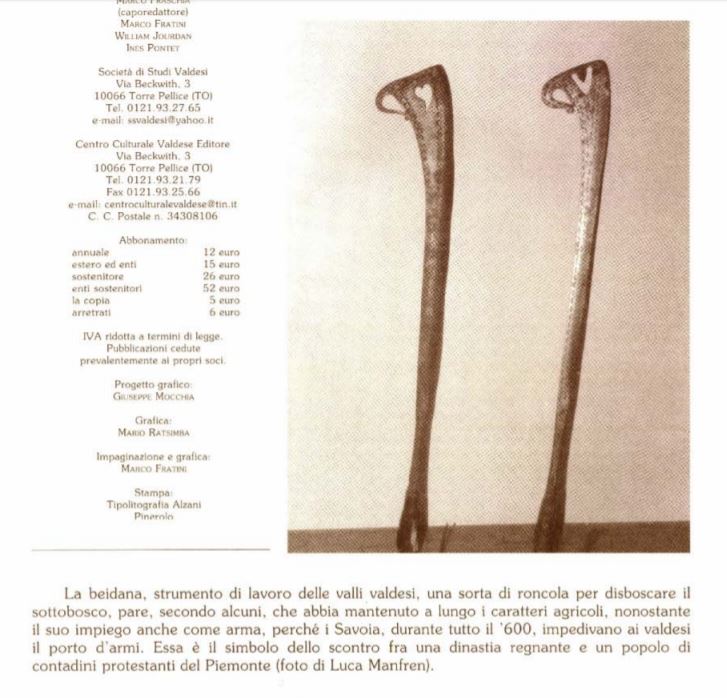
 Attachment: 172.82 KB Attachment: 172.82 KB

 Attachment: 34.68 KB Attachment: 34.68 KB
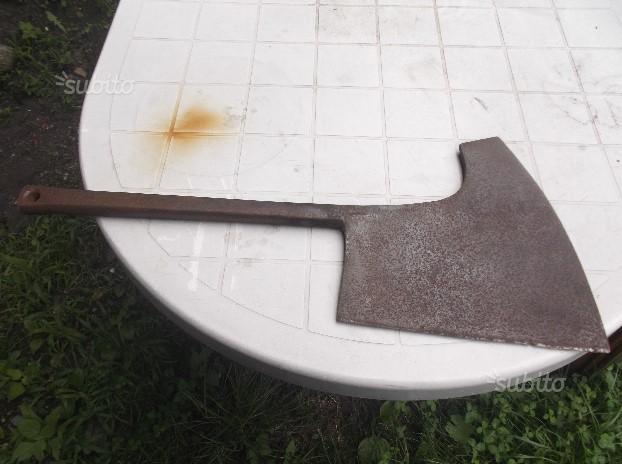
 Attachment: 52.31 KB Attachment: 52.31 KB
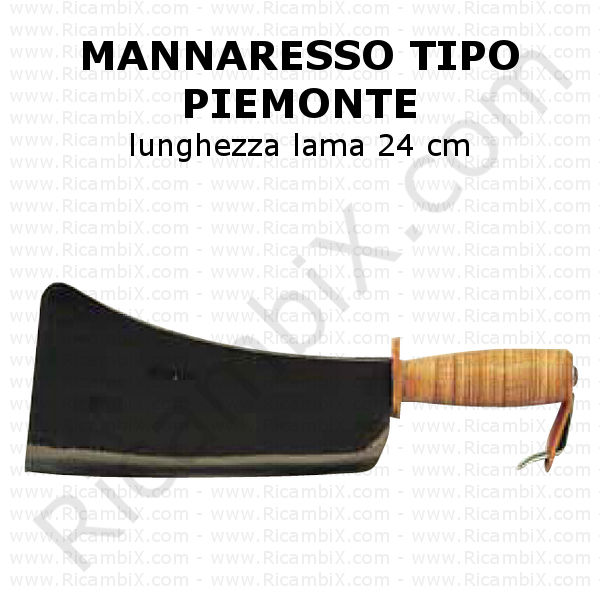
 Attachment: 41.41 KB Attachment: 41.41 KB
[ Download ]
Edge tool collector and historian, with a special interest in the billhook...
Last edited by Bob Burgess on Mon 04 Mar, 2019 3:25 am; edited 2 times in total
|
|
  |
 |
|
Bob Burgess
Location: Wiltshire UK Joined: 30 May 2011
Posts: 21
|
 Posted: Mon 04 Mar, 2019 3:15 am Post subject: Posted: Mon 04 Mar, 2019 3:15 am Post subject: |
 |
|
Replying to Geoffroy's mention of the forged integral bolster, just like on modern Sabatier chef's knives, the best ones have them, the cheaper ones don't... I have many Italian roncole - some have this, with either riveted scales of horn or compressed leather washers, and some don't..... I don't think its presence or lack thereof can be an indicator of whether a beidana is genuine or not....
Apologies for the poor images - from part of my collection...
 Attachment: 130.59 KB Attachment: 130.59 KB
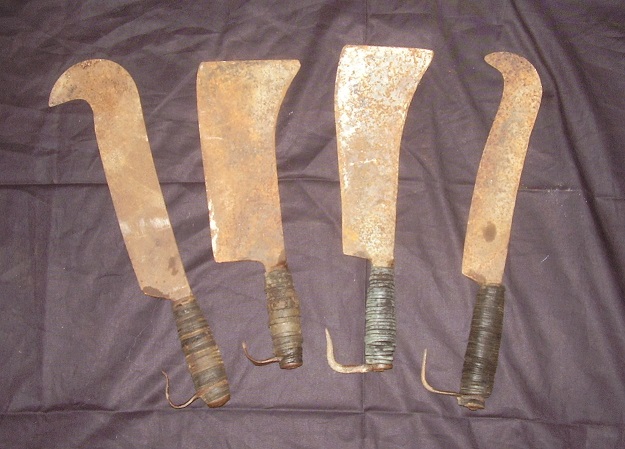
 Attachment: 161.37 KB Attachment: 161.37 KB
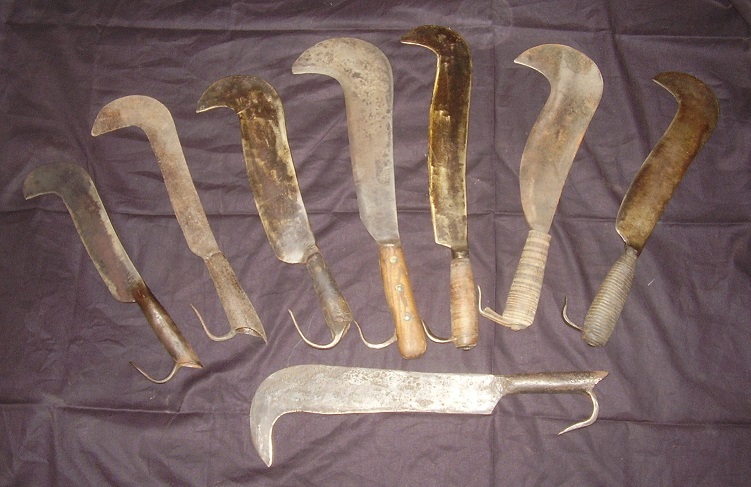
Edge tool collector and historian, with a special interest in the billhook...
|
|
  |
 |
Sa'ar Nudel

|
 Posted: Mon 04 Mar, 2019 3:43 am Post subject: Posted: Mon 04 Mar, 2019 3:43 am Post subject: |
 |
|
Bob, thanks for hopping on. That large two handed integral cleaver is very similar to the Alsatian fouille.
Another true Beidana I recently documented, in the archives of the Italian Artillery Corps museum, Turin.
As you can see, it is unusually long (appr. 80cm) and slender, very small hilt, lots of rustic decorations.
 Attachment: 93.97 KB Attachment: 93.97 KB
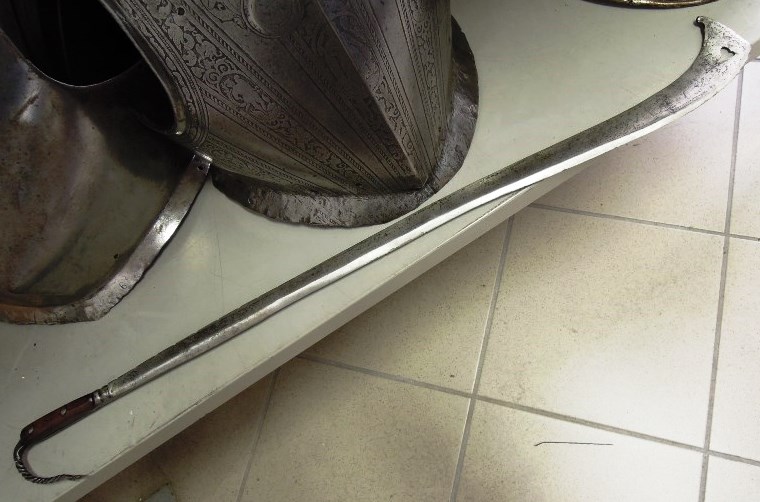
 Attachment: 90.65 KB Attachment: 90.65 KB
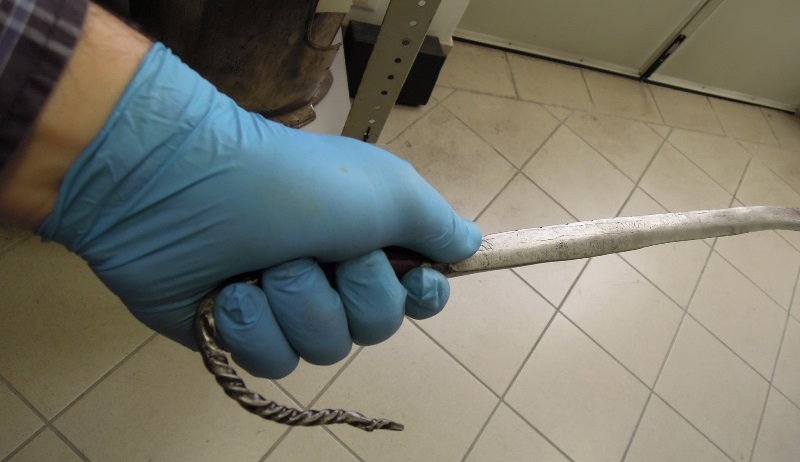
 Attachment: 95.14 KB Attachment: 95.14 KB
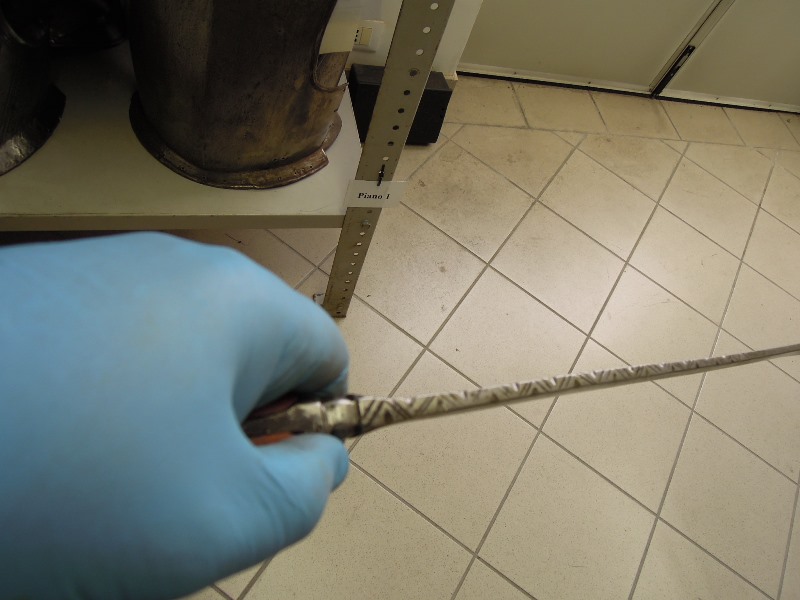
 Attachment: 93.98 KB Attachment: 93.98 KB
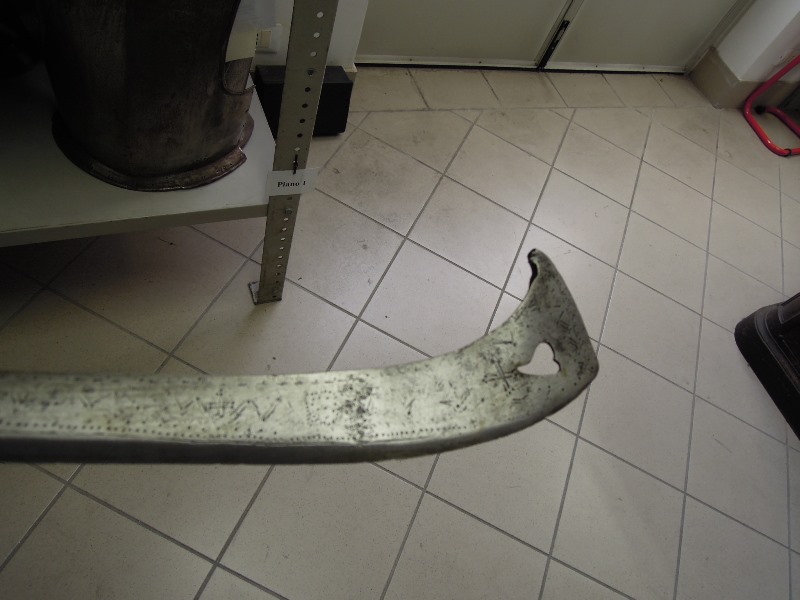
Curator of Beit Ussishkin, regional nature & history museum, Upper Galilee.
|
|
   |
 |
Dan Howard

|
 Posted: Mon 04 Mar, 2019 3:47 am Post subject: Posted: Mon 04 Mar, 2019 3:47 am Post subject: |
 |
|
They don't look any different to sugar cane knives.

 




Author: Bronze Age Military Equipment, Pen and Sword Books
|
|
  |
 |
|
Bob Burgess
Location: Wiltshire UK Joined: 30 May 2011
Posts: 21
|
 Posted: Mon 04 Mar, 2019 9:41 am Post subject: Posted: Mon 04 Mar, 2019 9:41 am Post subject: |
 |
|
Sa'ar - that one is magnificent....
Long billhooks are common in Italy and parts of France, but Italy in particular has long thin blades known as 'roncola per funghi' (mushroom billhooks - they must have pretty big mushroom there) or as a 'sfrattarola' - available as a single edge or double blades, The French version 'coupe ronces' (bramble hook - makes more sense) is similar....
Billhooks with a hook on the back are common throughout Europe - from Scandinavia, through Germany to Austria and Italy...
I suspect the beidana may have evolved from a combination of these features as well - a long narrow blade coupled with a back hook that became more decorative than functional... The hand guard and handle share a common ancestor with the roncola... As with the common billhook, the reasons for the evolution of so many subtle variants on a basic shape are now lost in the mists of time... Why tools from the mountainous regions are more decorative than those from other regions is probably down to long, cold winter days when it was impossible to get out of the house... Folk art of all kinds from embroidery, through wood carving to clock making was common in most mountainous regions of Europe, such as the Alps and its lesser ranges such as the foothills (Piemonte)... There may have even been a family input, with the smith doing the forging, and others doing the finishing such as decoration, fitting handles,,, Sadly we will never know for sure, but what is known is that many farmers (and most peasants were) had a secondary trade in the winter (e,g, as in France: edge tool making in Nan sous Ste Anne, or clock-making in Morez & Morbier)
Curiously I have not yet seen a beidana with an integrally forged tubular handle, as seen on many billhooks from both the French Piedmont and Italian Piemonte regions (as can be seen on one of my previous posts)....
To respond to Dan, the beidane have a similarity to a cane knife, in the same way that these were developed from the European billhook (or from a machete, which in turn was developed from a naval or military cutlass), but the development of the beidane into their current forms is unique to a small isolated area of the Piemonte, and has nothing to do with cutting sugar cane...
Images below: top: French single and double bladed 'serpes à ronces' (left of image); next: an Italian 'roncola per funghi', next: a Finnish 'hakukirves', and last: an Austrian 'praxe',...
 Attachment: 15.86 KB Attachment: 15.86 KB
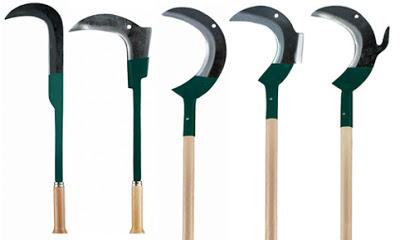
 Attachment: 11.2 KB Attachment: 11.2 KB
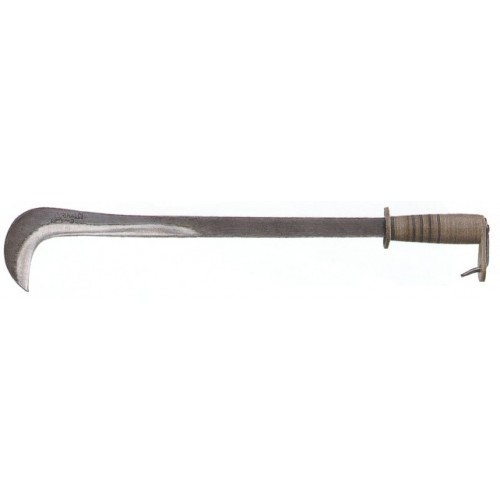
 Attachment: 8.26 KB Attachment: 8.26 KB
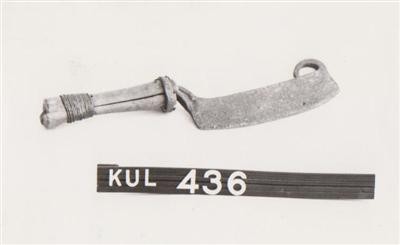
 Attachment: 3.63 KB Attachment: 3.63 KB
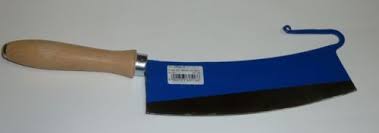
Edge tool collector and historian, with a special interest in the billhook...
|
|
  |
 |
|
Karl G
Location: Australia Joined: 25 Apr 2016
Posts: 66
|
 Posted: Fri 08 Mar, 2019 11:36 pm Post subject: Posted: Fri 08 Mar, 2019 11:36 pm Post subject: |
 |
|
The history of these weapons is not my area but as a guy who has used cane knives and machetes a lot for work I can say the features lend itself to work in several ways.
1. A slight curve and square end( not sure the correct terms) make a lot more resistant to impacting the ground if the target foliage needs to be cut at ground level. Using a cane knife or machete all day for actual cane or grasses you are hitting the ground a lot. You sharpen regularly and its no problem. Spear, clipped, sword or even seax tips much more likely to break off.
2. The back side hooks on an implement are a god send to your back. The cane knifes hook is a called a trash hook( trash being the dead material from sugarcane) and they enable you to tear dead material from stalks, or even pick up long objects up quickly with the hook and fling it aside. You can also gather a bunch of cut foliage using the hook for extra purchase. Once you get good with these the trashhook feels almost like having an extra thumb to grab stuff.
3. Anything with a hole in the end is great for hanging on a hook 
I have no idea what the italians used beidanas for but agricutlurally I'd use that blade them for long grasses, canes or species with long fibrous stalks that need to be cut low.
I just had a thought, maybe Saruman had his orcs doubling as cane cutters for extra industry 
|
|
   |
 |
|
|
You cannot post new topics in this forum
You cannot reply to topics in this forum
You cannot edit your posts in this forum
You cannot delete your posts in this forum
You cannot vote in polls in this forum
You cannot attach files in this forum
You can download files in this forum
|
All contents © Copyright 2003-2024 myArmoury.com — All rights reserved
Discussion forums powered by phpBB © The phpBB Group
Switch to the Basic Low-bandwidth Version of the forum
|

